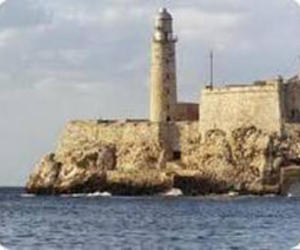Havana Fortress: Old Routes and New Stories
- Submitted by: manso
- Travel and Tourism
- 08 / 01 / 2011

31 de julio de 2011. Por Lianet Arias Sosa. Havana, (Prensa Latina) At the entrance of Havana Bay there is an image that dazzles the eyes and brings memories of old roads and new stories about the Fortress, commonly known as the Morro Castle, with its emblematic lighthouse and lights.
This military fortress was built four centuries ago to safeguard the city of San Cristobal de La Habana from pirates and corsairs, so common during colonial times.
The history books tell us that when Governor Diego de Mazariegos built a tower in 1563 the site had already been used for some time by sentries to warn the population in case of attacks.
This colossus, made of stone slabs, was named after the Biblical Magi -Castle of the Three Kings (Three Wise Men) of the East-, and its construction that had been commissioned to Italian military engineer Juan Bautista Antonelli was completed as long ago as 1589. Bautista Antonelli also built the fortress of San Salvador de la Punta, another of Havana's fortifications, and the Zanja Real, the city's first aqueduct.
After it was built, a lighthouse was added to the fortress. At first, it was lit with wood and in 1844 it was replaced by the lighting system that continues to serve ships entering the Havana port.
History recalls that in 1762, when the British stormed the city, Naval Captain Luis de Velasco organized a strong resistance from the fortress, and was able to withstand weeks of continuous attacks by the British marines and armies.
After the city was returned to the Spaniards, military engineers Silvestre Abarca and Agustine Crame began restoring in 1763 the Morro Castle, which had been damaged under the British attacks.
Specialists agree that the architectural edifice built on a high rock is representative of classical fortresses during that century, although the irregularity of the site where it was built prevented the perfect symmetry of the renaissance structures.
Eusebio Leal, Historian of the City, explains that when UNESCO declared Old Havana a Heritage of Humanity it not only included the old walled historical center but also its system of fortresses.
This, he explains, added value and recognized the additional protection provided by the City to commercial and military fleets that used to lay anchor in the port.
Today, walking along the cobblestone streets and going up and down the ramps of the fortress provides enjoyment for Cubans and foreigners alike. The Cuban government has turned these facilities into sightseeing sites and cultural centers such as museums of history.
Thus, the historical-military Morro-Cabana Park made up of both former military facilities is the home every year of the Havana International Book Fair, offering literary wonders for all ages. It also hosts the Cuban Tourism Fair.
From the watch towers that used to scan the seas, the city emerges at night filled with lights, separated from the waters by the long boardwalk (malecón) that lines the port, and serves as an inspiration for lovers.
In the eastern city of Santiago de Cuba, there is another impressive fortress called San Pedro de la Roca that was built in the 17th century. Like the "Three Kings" Fortress in Havana, it guarded Santiago against pirates and corsairs, and today is an attractive museum of history.
Memories of old canons, and ancient costumes, and even the naval battle during the war between the independence fighters of this Island, Spain and the United States at the end of the 19th century, are revived for new generations through works of restoration and conservation of sites such as these.
To preserve and respect them is an ideal of the people of this country, accustomed to the sea and surrounded by it, who with more than a cultural, summertime or romantic pretext, come to visit the old fortresses with the hope of finding new and necessary experiences.
Comments